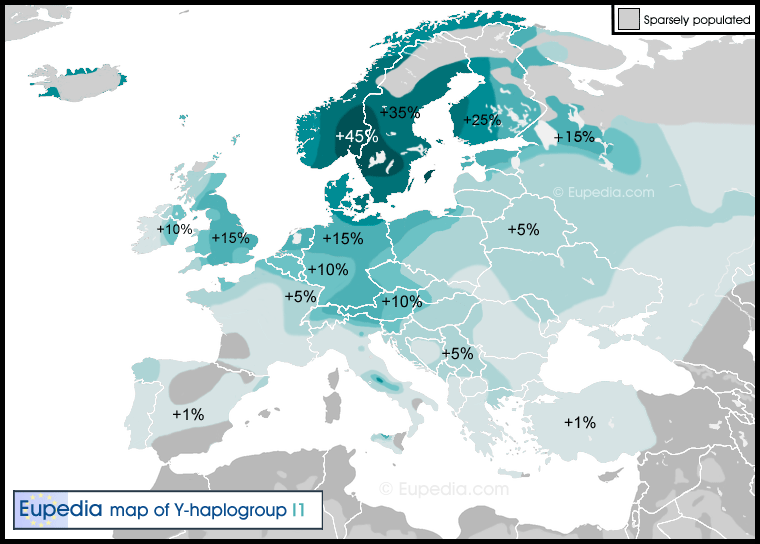I1a Potts (I-M253)
I1a – Northern European Potts Family Line
Haplogroup I-M253 – Scandinavian Potts Line
Five confirmed members of POTTS Ancestry have had yDNA testing and have been confirmed as haplogroup I-M253. Information is available on on 4 of these descendants. Their oldest Paternal Ancestor information is as follows:
- Carl Josef Lind – born 1855 Finland
- Oliver Cromwell Potts – born 1824 and died 1882
- Thomas Potts – born 1636 Lindloes Wales and died 1706 Philadelphia
- Andrew J. Potts – born 1832 and 1892
They are listed in the Potts DNA Project.

Haplogroup I1 is the most common I subclade in northern Europe. It is found mostly in Scandinavia and Finland, where it typically represent over 35% of the male Y-chromosomes. Associated with the Norse ethnicity, I1 is found in all places invaded by ancient Germanic tribes and the Vikings. Other parts of Europe speaking Germanic languages come next in frequency. Germany, Austria, the Low Countries, England and the Scottish Lowlands all have between 10% and 20% of I1 lineages.
Haplogroup I-M253, also known as I1, is a Y chromosome haplogroup. The genetic markers confirmed as identifying I-M253 are the SNPs M253,M307.2/P203.2, M450/S109, P30, P40, L64, L75, L80, L81, L118, L121/S62, L123, L124/S64, L125/S65, L157.1, L186, and L187.[5] It is a primary branch of Haplogroup I-M170 (I*).
The haplogroup reaches its peak frequencies in Sweden (52 percent of males in Västra Götaland County) and western Finland (more than 50 percent in Satakunta province).[6] In terms of national averages, I-M253 is found in 35–38 per cent of Swedish males,[7] 32.8% of Danish males,[8] about 31.5% of Norwegian males,[9] and about 28% of Finnish males.[10]
Haplogroup I-M253 is a primary branch of haplogroup I* (I-M170), which has been present in Europe since ancient times. The other primary branch of I* is I-M438, also known as I2.
Before a reclassification in 2008,[11] the group was known as I1a, a name that has since been reassigned to a primary branch, haplogroup I-DF29. The other primary branches of I1 (M253) are I1b (S249/Z131) and I1c (Y18119/Z17925).
Resources for Haplogroup I-M253
Glossary
- Clade comes from the Greek word Klados = branch. A Clade on the Y Chromosome tree is also called a Haplogroup. Subclade is a term to describe the relationship between two clades with the sub-clade being downstream (occurring later in time). A Clade includes all the descendants of a single founder (common ancestor).
- Haplogroup is defined as a group of similar Haplotypes that share a common ancestor with a Single Nucleotide Polymorphism (SNP) mutation. Your Haplogroup tells much about your ancient ethnic origins. Meaning thousands of years ago. In the case of our I2a Haplogroup, we all share the SNP (called Snip) I-P37.2+. The I2a Haplogroup has numerous subgroups or subclades, all determined by various other SNPs which we will discuss later.
- SNP is defined as a change in the DNA which happens when a single nucleotide (A, T, G or C) in the genome sequence is altered. A person has many SNPs that together create a unique DNA pattern for that individual. Snips clarify the branching of a tree–separation of different subhaplogroups.
- Haplotype is defined as one person’s set of values for the DYS markers that have been tested. In other words, your yDNA test results. Think of Haplotypes as leaves on a tree, and a Haplogroup as a limb of that tree. Haplotype is a contaction of the phrase “haploid genotype”.
- Allele is defined as a DNA sequence that repeats at a certain location (DYS marker) on the Y Chromosome. The Allele value is the number of times the sequence repeats. Pronounced uh-LEEL.
- STR is a short DNA motif (pattern) repeated in tandem. A, T, G or C repeated eleven times would give the DYS marker a value or allele of eleven. DYS is short for DNA/ Y-Chromosome/ Segment. The name of a marker on the Y-Chromosome.